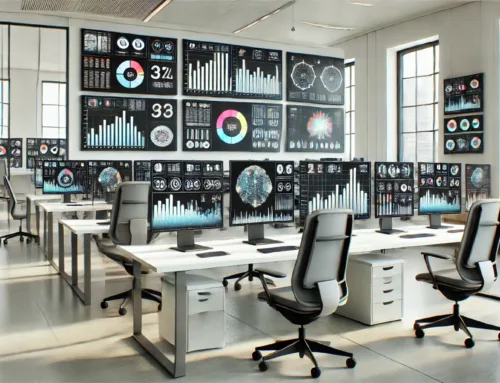Did you know that training your data visualization agency team involves more than just generic workshops? Understanding the specific skill gaps and learning styles of your team members can significantly impact the effectiveness of your training initiatives. By tailoring your approach to address individual needs and preferences, you can unlock the full potential of your team’s data visualization capabilities. Stay tuned to discover practical strategies for maximizing your team’s performance and achieving success in data visualization projects.
Identify Training Needs
When identifying the training needs of your data visualization agency team, it is crucial to conduct a comprehensive assessment of their current skills and knowledge gaps. Skill assessment plays a key role in understanding where your team stands and what areas need improvement. By evaluating their proficiency in data visualization tools, techniques, and design principles, you can pinpoint specific areas that require attention. This assessment sets the foundation for devising targeted training programs that address the skill gaps identified.
Performance improvement is at the core of skill assessment. Once you have identified the areas where your team needs development, you can tailor training initiatives to enhance their capabilities effectively. Whether it’s improving their data interpretation skills, refining their storytelling abilities through visualizations, or enhancing their understanding of best practices in the industry, the goal is to elevate their performance levels. By focusing on targeted training that addresses their specific needs, you can empower your team to excel in their roles and drive better results for your agency.
Choose Appropriate Training Programs
To effectively enhance the skills of your data visualization agency team, selecting appropriate training programs is paramount. Skill development is crucial for keeping your team up-to-date with the latest trends and techniques in data visualization. When choosing training programs, consider the specific needs identified in the previous step. Allocate resources wisely by investing in programs that directly address these needs and align with your team’s goals. Look for courses or workshops that focus on areas where improvement is needed, such as advanced data analysis, storytelling with data, or mastering data visualization tools. Ensure that the training programs you select are reputable and led by experienced professionals in the field. By investing in the right training programs, you can equip your team with the skills and knowledge necessary to excel in data visualization, ultimately boosting their performance and the overall success of your agency.
Schedule Training Sessions
To effectively put your selected training programs into action and enhance the skills of your data visualization agency team, the next step is to schedule training sessions. This is crucial for fostering team collaboration and promoting skill development within your agency. Here are three key points to consider when scheduling training sessions:
- Set Clear Objectives: Define specific learning outcomes for each training session to ensure that team members understand what skills they will develop and how it will benefit their work.
- Establish a Regular Schedule: Consistency is key to skill improvement. Plan regular training sessions to provide continuous learning opportunities for your team members.
- Encourage Peer Learning: Facilitate opportunities for team members to share their knowledge and expertise with each other. This fosters collaboration and creates a supportive learning environment where everyone can benefit from each other’s skills.
Monitor Training Progress
Monitoring training progress is essential for ensuring that your data visualization agency team is effectively absorbing and applying the new skills acquired during training sessions. To track performance and measure effectiveness, consider implementing regular assessments or quizzes to gauge understanding and knowledge retention. Encourage team members to provide feedback on the training sessions to identify areas that may need further clarification or focus.
Utilize key performance indicators (KPIs) to objectively measure progress and improvement in data visualization skills. This could include tracking the time taken to complete tasks, the accuracy of visualizations created, or the complexity of projects tackled post-training. By monitoring these metrics, you can pinpoint areas where additional support or training may be necessary.
Additionally, consider conducting one-on-one check-ins with team members to discuss their progress, challenges faced, and goals moving forward. This personalized approach can provide valuable insights into individual learning journeys and help tailor future training sessions to address specific needs. Remember, effective monitoring of training progress is crucial for continuously enhancing the skills and capabilities of your data visualization agency team.
Provide Real-World Examples
When providing training for your data visualization agency team, incorporating real-world examples is crucial for reinforcing concepts and enhancing practical skills. Real-world examples bring theoretical concepts to life, making it easier for your team to understand and apply them effectively. Here are some ways to effectively provide real-world examples during training:
- Case Studies: Presenting case studies relevant to your industry helps team members see how data visualization techniques have been successfully applied in similar scenarios.
- Brainstorming Sessions: Encourage brainstorming sessions where team members can apply the concepts learned to real-world scenarios, fostering creativity and problem-solving skills.
- Industry Trends & Best Practices: Showcasing current industry trends and best practices through real-world examples helps team members stay updated and adapt their skills to meet evolving standards.
Frequently Asked Questions
How Can We Ensure Long-Term Retention of Training Content?
To ensure long-term retention of training content, implement effective retention strategies. Encourage continuous learning through knowledge transfer sessions. Utilize interactive activities, regular assessments, and real-world applications. Keep content relevant, engaging, and easily accessible for ongoing skill development.
What Are the Best Ways to Address Resistance to Training?
Addressing resistance to training is crucial. Overcoming objections starts with understanding concerns. Present compelling reasons for change. Acknowledge fears and offer support. Utilize interactive sessions to engage and personalize learning. Encourage feedback for continuous improvement.
Are There Any Tools or Resources to Support Ongoing Learning?
To support ongoing learning, you can explore online courses and webinars for flexible education. Additionally, attending data visualization workshops and conferences provides valuable hands-on experience. These resources help you stay updated and expand your skills effectively.
How Do We Measure the Impact of Training on Project Outcomes?
To measure the impact of training on project outcomes, evaluate project effectiveness post-training. Conduct outcome measurements to assess changes in performance and productivity. Use impact assessments to quantify the influence of training on achieving project goals and objectives.
What Strategies Can We Use to Encourage a Culture of Continuous Learning?
To foster continuous learning within your team, focus on team engagement and learning plans. Encourage skill development through knowledge sharing sessions. Create a culture where curiosity is valued, and provide opportunities for growth and development.




